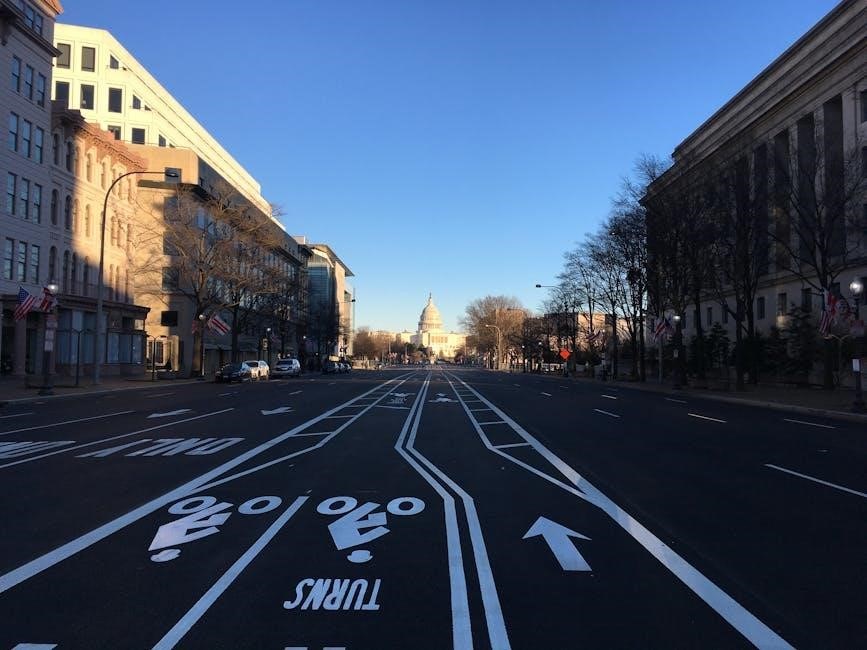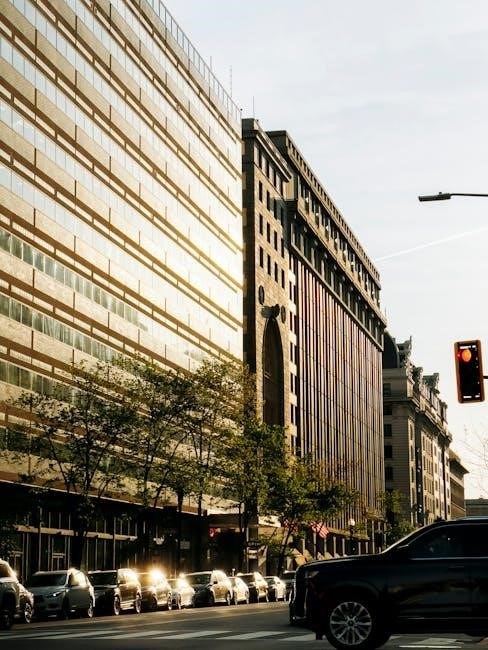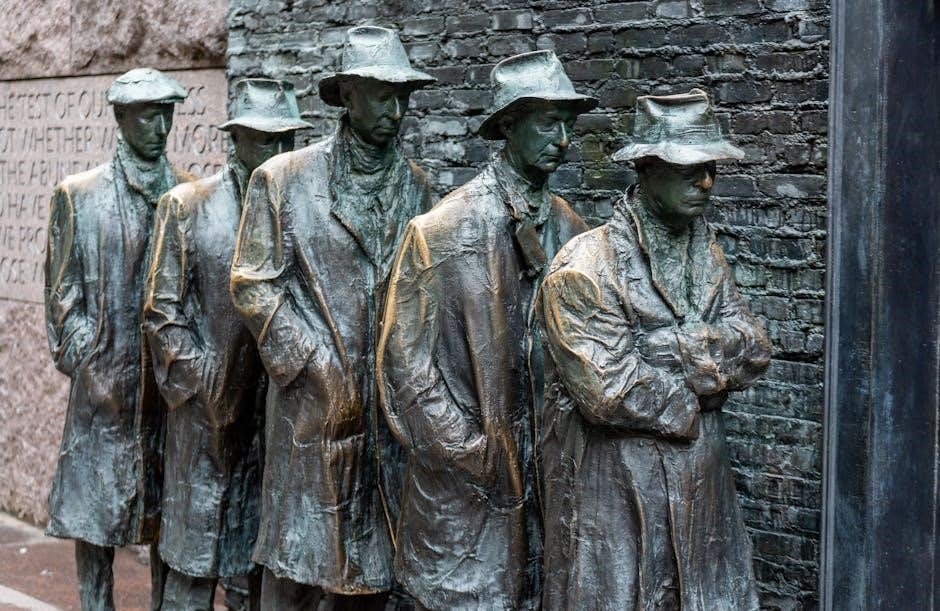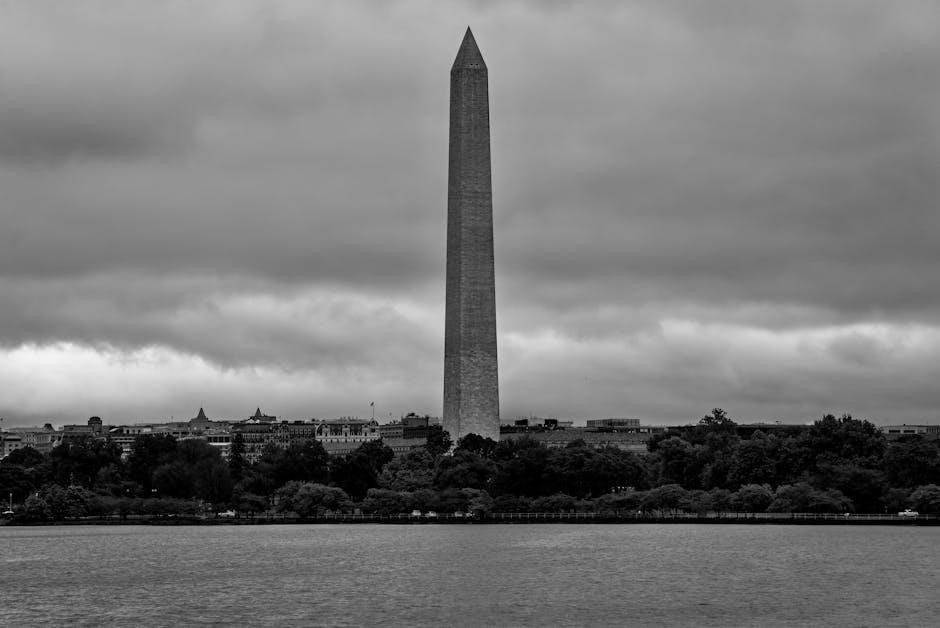The Washington DC Drivers Manual is a comprehensive guide published by the District of Columbia DMV. It covers traffic laws, road signs, and safe driving practices. Studying this manual is essential for preparing for the knowledge test and becoming a responsible driver in Washington DC.
1.1 Purpose of the Manual
The Washington DC Drivers Manual is designed to provide drivers with essential information to operate vehicles safely and legally in the District of Columbia. Its primary purpose is to educate new and experienced drivers on traffic laws, road signs, and safe driving practices. The manual covers topics such as road rules, license requirements, and vehicle safety to ensure drivers are well-prepared for the knowledge test and real-world driving scenarios. It serves as a key resource for obtaining a driver’s license, renewing a license, or understanding DC-specific driving regulations. The manual is available in multiple formats, including PDF and online versions, for easy access.
1.2 Structure and Content
The Washington DC Drivers Manual is organized into clear sections, making it easy to navigate and study. It begins with an introduction to the manual itself, followed by detailed chapters on obtaining a driver’s license, traffic laws, safe driving practices, and the driver’s license examination process. Additional sections cover special licenses, vehicle ownership, and road signs. The manual also includes resources for practice tests and tips for first-time drivers. Each chapter is designed to provide specific information, ensuring drivers are well-prepared for both the knowledge test and real-world driving scenarios in Washington DC.
1.3 Importance of Studying the Manual
Studying the Washington DC Drivers Manual is crucial for understanding traffic laws, road signs, and safe driving practices. It prepares individuals for the knowledge test, ensuring they can operate a vehicle safely and legally in Washington DC. The manual provides essential information for both new and experienced drivers, helping to reduce accidents and promote responsible driving habits. By thoroughly reviewing the manual, drivers can gain the knowledge and confidence needed to navigate DC roads effectively and comply with all traffic regulations.

Obtaining a Driver’s License in Washington DC
This section provides a detailed guide on obtaining a driver’s license in Washington DC, including the application process, required tests, and the role of the manual in preparation.
2.1 Eligibility Requirements
To obtain a driver’s license in Washington DC, applicants must meet specific eligibility criteria. Individuals must be at least 16 years old to apply for a learner’s permit. For minors under 18, parental consent is required. Applicants must provide proof of identity, residency, and Social Security number. A vision test is mandatory, and applicants under 21 must complete a driver’s education course. Additional documentation, such as birth certificates or immigration documents, may be needed. Applicants must also pay the required fees and pass the written knowledge test. The DC DMV outlines these requirements to ensure safe and legal driving practices.
2.2 Types of Driver’s Licenses
The District of Columbia offers several types of driver’s licenses tailored to different needs. A standard Class C license is for operating passenger vehicles. A Class M license is required for motorcycles, while a Commercial Driver’s License (CDL) is needed for large or specialty vehicles. Provisional licenses are issued to young drivers transitioning from a learner’s permit. Additionally, specialized licenses, such as chauffeur or government official licenses, are available for specific occupations. Each license type has distinct requirements and restrictions, ensuring safe and appropriate vehicle operation based on the applicant’s qualifications and intended use.
2.3 Application Process

To apply for a driver’s license in Washington DC, you must gather required documents, such as proof of identity, residency, and Social Security. Visit a DC DMV Service Center and submit your application. A vision screening is mandatory, and you may need to pass a knowledge test. Fees vary by license type and must be paid at the time of application. If applying for a learner’s permit, you must wait 14 days before taking the road skills test. Virtual knowledge tests are available by appointment, but the final road test requires an in-person visit. Ensure all eligibility documents are ready to avoid delays.
2.4 Fees and Payment Methods
The District of Columbia DMV charges specific fees for driver’s licenses, permits, and related services. A standard driver’s license costs $47, while a commercial license (CDL) or motorcycle license may incur higher fees. Payment can be made using cash, credit cards, money orders, or traveler’s checks. Online transactions may include a convenience fee. Fees are non-refundable, even if the application is denied. Ensure to verify current fee structures on the DC DMV website before applying. Proper payment is essential to complete the licensing process and obtain your driver’s permit or license.

Traffic Laws and Regulations
Washington DC enforces strict traffic laws, including right-of-way rules, speed limits, and parking restrictions. Double solid yellow lines prohibit crossing unless turning, ensuring safety on DC roads.
3.1 Road Signs and Meanings
Road signs in Washington DC are essential for safe driving and understanding traffic rules. They are categorized into guide signs, warning signs, and construction signs. Guide signs provide directional information, such as route numbers or destinations. Warning signs alert drivers to potential hazards, like curves or pedestrian crossings. Construction signs indicate roadwork or detours. Understanding these signs is critical for navigating DC roads safely and passing the DMV knowledge test. Familiarizing yourself with their shapes, colors, and symbols ensures compliance with traffic laws and enhances overall road safety.
3.2 Speed Limits and Right-of-Way Rules
Speed limits in Washington DC vary depending on the location, typically ranging from 25 to 45 mph in urban areas. Right-of-way rules ensure orderly traffic flow. Drivers must yield to pedestrians and cyclists at crosswalks and intersections. At four-way stops, the vehicle on the right has priority. When merging onto highways, yield to traffic already on the road. Failure to follow these rules can result in fines or loss of license points. Understanding these regulations is crucial for safe driving and passing the DMV knowledge test, as outlined in the Washington DC Drivers Manual.
3.3 Parking and Stopping Laws
Parking and stopping laws in Washington DC are designed to ensure traffic flow and pedestrian safety. Vehicles must park in designated spaces and adhere to metered parking rules. Failure to pay or exceeding time limits results in fines or towing. Double parking, blocking fire hydrants, and stopping in bus or bike lanes are prohibited. Drivers must also obey no-parking zones, especially near schools, hospitals, and intersections. Illegal parking can lead to penalties, including fines and vehicle impoundment. Understanding these rules is essential for avoiding violations and ensuring public safety, as detailed in the Washington DC Drivers Manual.

Safe Driving Practices
Safe driving practices in Washington DC emphasize defensive techniques, sharing roads with pedestrians and cyclists, and navigating adverse weather conditions to ensure roadway safety and reduce accidents.
4.1 Defensive Driving Techniques
Defensive driving techniques are crucial for maintaining safety on Washington DC roads. These methods emphasize anticipation, awareness, and cautious behavior. Drivers should always stay alert, follow speed limits, and maintain a safe distance from other vehicles. Being prepared for unexpected actions by other drivers and pedestrians is key. Additionally, avoiding distractions like using smartphones while driving is stressed. The District of Columbia DMV manual highlights these practices to help drivers minimize risks and prevent accidents, ensuring a safer environment for all road users. Regular practice and adherence to these techniques can significantly improve driving safety in urban areas like Washington DC.
4.2 Sharing the Road with Pedestrians and Cyclists
Sharing the road with pedestrians and cyclists requires mutual respect and awareness. Drivers must yield to pedestrians at crosswalks and be cautious near schools, parks, and busy intersections. Cyclists have the same rights as vehicles, so drivers should maintain a safe distance and avoid sudden lane changes. Pedestrians should use crosswalks and follow traffic signals, while cyclists must obey traffic laws and use designated bike lanes when available. The Washington DC drivers manual emphasizes the importance of patience and vigilance to ensure safety for all road users. By following these guidelines, drivers can help create a safer and more harmonious transportation environment.
4.3 Driving in Adverse Weather Conditions
Driving in adverse weather conditions requires extra caution and attention. Reduce speed and increase following distance to maintain control. Use low beams in fog or heavy rain to avoid blinding others. Avoid sudden movements and brake gently to prevent skidding. Be cautious on wet or icy roads, as stopping distances increase. If visibility is poor, use fog lights or pull over until conditions improve. Keep windshield wipers in good condition and ensure tires have adequate tread for traction. Always prioritize safety and be prepared for unexpected hazards. By following these tips, drivers can navigate challenging weather conditions more safely and confidently.

Driver’s License Examination
The Washington DC driver’s license examination includes a written knowledge test, vision screening, and road skills test. The exam ensures applicants understand traffic laws and safe driving practices.
5.1 Written Knowledge Test
The written knowledge test assesses understanding of traffic laws, road signs, and safe driving practices in Washington DC. It is available in multiple languages and can be taken virtually or at a DMV Service Center. A fee is required for each attempt. Applicants must pass to proceed to the vision screening and road test. The test results are valid for 14 business days. If failed, applicants must wait three calendar days before retaking the test. Using smart devices or study materials during the test is prohibited and results in a 60-day retake ban. Practice tests and the DC Drivers Manual are recommended for preparation.
5.2 Vision Screening
The vision screening is a mandatory step in the licensing process to ensure applicants can safely operate a vehicle. It assesses visual acuity, field of vision, and color blindness. Applicants must meet the District of Columbia’s vision standards. Those who fail the screening must provide a medical evaluation from a licensed professional. Corrective lenses are permitted if they improve vision to meet the required standards. The screening is conducted at DMV Service Centers and is a critical component of the driver’s license application process, ensuring road safety for all drivers in Washington DC.
5.3 Road Skills Test
The road skills test evaluates your ability to safely operate a vehicle. It is scheduled by appointment and requires a valid learner’s permit. The test assesses basic vehicle control, parking skills, turning, stopping, and merging. Applicants must use a properly insured and registered vehicle. If you fail, you must wait seven calendar days before retrying. The test is conducted by a DMV examiner who evaluates your driving techniques and adherence to traffic laws. Passing this test is the final step to obtaining a driver’s license, ensuring you demonstrate safe and competent driving abilities on Washington DC roads.

Special Licenses and Permits
Washington DC offers specialized licenses, including Commercial Driver’s Licenses (CDLs) for heavy vehicles, motorcycle licenses, and learner’s permits for new drivers. Each requires specific eligibility and testing.
6.1 Commercial Driver’s License (CDL)
A Commercial Driver’s License (CDL) is required to operate heavy vehicles in Washington DC. Eligibility includes being at least 21 years old, passing a vision test, and completing a CDL application. Applicants must choose between CDL classes (A, B, C) based on the vehicle type. Endorsements for special cargo, like hazardous materials, require additional testing. The DC DMV manual details CDL requirements, including fees and medical certifications. Studying the CDL section ensures readiness for the knowledge and skills tests, essential for obtaining this specialized license.
6.2 Motorcycle License
To obtain a motorcycle license in Washington DC, applicants must be at least 18 years old or 16 with parental consent. The process involves passing a vision test, completing a motorcycle safety course, and taking a road skills test. A learner’s permit is required before applying. The DC DMV manual provides detailed information on motorcycle-specific rules, safety tips, and licensing requirements. Studying the manual is crucial for understanding traffic laws and safe riding practices, ensuring readiness for the tests and responsible motorcycle operation in the District.
6.4 Learner’s Permit and Provisional License
A learner’s permit is required before applying for a full driver’s license in Washington DC. Applicants must be at least 16 years old and meet specific eligibility criteria. The permit allows driving under the supervision of a licensed driver. A provisional license is issued after holding the permit for a required period and passing a road test. Restrictions, such as limited driving hours and passenger limits, apply during this phase. The DC DMV manual outlines the steps to obtain these licenses, emphasizing the importance of adherence to rules and safe driving practices during the learning process.

Vehicle Ownership and Maintenance
Registering a vehicle in Washington DC requires proof of ownership, insurance, and passing a safety inspection. Regular maintenance ensures compliance with safety standards and extends vehicle lifespan.
7.1 Registering a Vehicle in Washington DC
Registering a vehicle in Washington DC involves submitting required documents, such as proof of ownership, insurance, and a passed safety inspection. Owners must visit a DC DMV Service Center with a completed registration application. Fees vary based on vehicle type and weight. Payment methods include cash, credit cards, or checks. Temporary tags are issued until permanent registration is processed. Non-residents must provide an out-of-state title or registration. Proper registration ensures compliance with DC laws and avoids penalties. The DC DMV also offers online registration renewal for convenience. Ensure all documents are valid and up-to-date to complete the process smoothly.
7.2 Insurance Requirements
In Washington DC, vehicle owners must maintain minimum liability insurance coverage to legally operate a vehicle. The required coverage includes $25,000 for bodily injury per person, $50,000 per accident, and $10,000 for property damage. Drivers must carry proof of insurance in their vehicle at all times. Insurance policies must be issued by a DC-licensed provider. Failure to provide proof of insurance during a traffic stop or vehicle registration can result in fines, penalties, or registration suspension. Ensuring proper insurance coverage is crucial for compliance with DC laws and protecting against financial losses in case of accidents.
7.3 Vehicle Safety Inspections
Vehicle safety inspections in Washington DC ensure that vehicles meet minimum safety standards. All vehicles registered in DC must pass a safety inspection, which includes checks on brakes, tires, lights, and emissions. Inspections are conducted at authorized DMV service centers or licensed inspection stations. The process typically takes 30 minutes and covers essential components to ensure roadworthiness. Failure to pass may require repairs before re-inspection. Regular inspections help maintain public safety and reduce the risk of accidents caused by unsafe vehicles. Keeping your vehicle inspected is a legal requirement for registration renewal in the District of Columbia.

Road Signs and Signals
Road signs and signals in Washington DC guide drivers, ensuring safe navigation. They include traffic control signals, guide signs, warning signs, and construction signs, each serving specific purposes.
8.1 Traffic Control Signals
Traffic control signals in Washington DC are essential for regulating the flow of vehicles and pedestrians. These signals include red, yellow, and green lights, each indicating when drivers should stop, prepare to stop, or proceed. Additionally, pedestrian signals and turning arrows provide specific instructions for different road users. Understanding and obeying these signals is critical for maintaining traffic order and preventing accidents. Ignoring traffic signals can lead to serious consequences, including collisions and legal penalties. The DC Drivers Manual emphasizes the importance of adhering to all traffic control signals to ensure safety and compliance with local laws.
8.2 Guide Signs and Warning Signs
Guide signs and warning signs are crucial for safe navigation in Washington DC. Guide signs provide directional information, helping drivers identify routes, destinations, and distances. Warning signs alert drivers to potential hazards, such as curves, intersections, or pedestrian crossings, allowing them to adjust their speed and driving behavior. These signs are designed to enhance traffic flow and reduce accidents. Understanding the shapes, colors, and symbols of guide and warning signs is essential for all drivers. The DC Drivers Manual details these signs to ensure drivers can recognize and respond to them effectively while on the road.
8.3 Construction and Maintenance Signs
Construction and maintenance signs are essential for ensuring safety in work zones. These signs, often orange in color, alert drivers to lane closures, detours, and workers present. They include symbols for roadwork, flaggers, and reduced speed limits. Understanding these signs helps drivers navigate construction areas safely. The manual details how these signs guide traffic flow and protect both drivers and construction workers. Recognizing and obeying these signs is crucial to prevent accidents and ensure smooth travel through work zones in Washington DC.

Additional Resources and Tips
The manual offers practice tests, DMV office locations, and tips for first-time drivers. These resources help prepare for exams and promote safe driving practices in Washington DC.
9.1 Practice Tests and Study Materials
The DC DMV provides official practice tests and study materials to help prepare for the knowledge exam. These resources include interactive quizzes, downloadable PDF guides, and online tutorials. Practice tests cover topics like road signs, traffic laws, and safe driving practices, mirroring the actual exam format. Additional study materials, such as the DC Drivers Manual, are available in multiple languages, including English and Spanish. Utilizing these resources enhances knowledge retention and ensures readiness for the examination. They are designed to complement manual study and provide a comprehensive understanding of District of Columbia driving regulations.
9.2 DMV Office Locations and Hours
The District of Columbia DMV operates multiple service centers across Washington DC, offering convenient locations for drivers to access services. Office hours vary by location but typically include weekday operations, with select centers offering extended hours during evenings or weekends. Services such as knowledge tests, license applications, and vehicle registrations are available. To ensure efficient service, appointments are recommended for certain transactions. Visit the official DC DMV website or contact their customer service for the most up-to-date information on locations, hours, and available services. Planning your visit in advance can save time and streamline your experience.
9.3 Tips for First-Time Drivers
For first-time drivers, studying the Washington DC Drivers Manual is crucial. Practice with online tests to ensure readiness for the knowledge exam. Familiarize yourself with local traffic laws and road signs. Consider practicing in low-traffic areas to build confidence. Always stay alert and follow defensive driving techniques. Keep a safe distance from other vehicles and adhere to speed limits. Avoid distractions like using a cellphone while driving. Ensure proper vehicle maintenance for safety. Lastly, seek guidance from experienced drivers or instructors to refine your skills. These tips will help you navigate the roads safely and responsibly in Washington DC.
